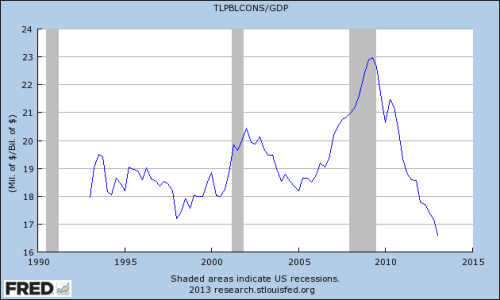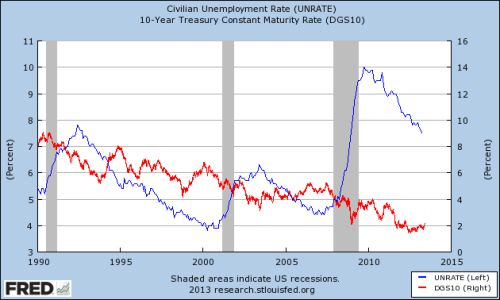Are we spending too much or too little on infrastructure?
American infrastructure has improved since the 80s. But it still may be inadequate.

Infrastructure — roads, bridges, rail, airports, seaports, waste management, dams, water treatment, electrical grids, the internet, etc — is the backbone of the modern economy, the base upon which the rest of industry sits. When infrastructure works, businesses, individuals and societies can go about their business — travel, shop, ship goods to customers, drink clean water, easily dispose of waste, access information through the internet, etc. When infrastructure fails or doesn't exist, businesses, individuals, and societies face huge problems.
In the U.S., public construction spending (i.e., infrastructure spending) as a proportion of GDP has recently fallen to a low:

At the same time, the American Society of Civil Engineers, which produces the American Infrastructure Report Card, estimates that American infrastructure is deficient, giving the U.S. a D+ grade for infrastructure, and calling for $3.6 trillion of extra spending by 2020 to fix the holes.
The Week
Escape your echo chamber. Get the facts behind the news, plus analysis from multiple perspectives.

Sign up for The Week's Free Newsletters
From our morning news briefing to a weekly Good News Newsletter, get the best of The Week delivered directly to your inbox.
From our morning news briefing to a weekly Good News Newsletter, get the best of The Week delivered directly to your inbox.
Their conclusion:
For the U.S. economy to be the most competitive in the world, we need a first class infrastructure system — transport systems that move people and goods efficiently and at reasonable cost by land, water, and air; transmission systems that deliver reliable, low-cost power from a wide range of energy sources; and water systems that drive industrial processes as well as the daily functions in our homes. Yet today, our infrastructure systems are failing to keep pace with the current and expanding needs, and investment in infrastructure is faltering. [American Infrastructure Report Card]
However, it is possible to over-invest in infrastructure. Look at China, which has thrown so much money at infrastructure in recent years that the world's most populous nation now has virtually empty ghost cities that nobody wanted in the first place, and that nobody wants now. But the phenomenon in the U.S. is totally different — the infrastructure that the engineers suggest improving is infrastructure that is already in place, and in use.
In spite of the engineers' warnings, many say that American infrastructure is not so bad. In an unfortunately titled Bloomberg op-ed called "The Myth of the Falling Bridge" — unfortunate, because just over a month later, a Washington State bridge collapsed — columnist Evan Soltas asked, "Is the quality of infrastructure worsening?" He concluded that American infrastructure was actually improving.
A free daily email with the biggest news stories of the day – and the best features from TheWeek.com
Believe it or not, infrastructure has improved significantly over the last two decades. In its report for 2010, the Federal Highway Administration said that 57 percent of all vehicle-miles were traveled on federal highways with ratings of "good" or higher.
That was up from 48 percent in 2000. The percentage of roads in bad condition has also declined: In 1989 6.6 percent of rural and urban interstates were rated "poor"; now only 1.9 percent of rural interstates and 5.4 percent of urban ones earn that grade.
Despite warnings from President Barack Obama, America's bridges have never been safer. The highway administration rated 21.9 percent of its bridges "deficient" in 2009, as compared to 37.8 percent in 1989. And contrary to Obama's implication, the word "deficient" does not mean unsafe, at least as the highway administration uses it. A bridge is "deficient" when it would benefit from expansion and renovation in line with usage.
Traffic congestion has diminished. In 1989, 52.6 percent of urban interstates were rated "congested" according to a comparison of peak volume to planned capacity. In 2009, the figure was 26.3 percent. [Bloomberg]
So the Federal Highway Administration agencies note that American infrastructure is improving, but the American Society of Civil Engineers note that it is severely deficient. Who should be believed? Well, in the long run perhaps both are right — American infrastructure may have improved since the late '80s, but that doesn't mean that it's adequate. And clearly, falling bridges are not a myth.
But from an economic perspective, in the short term the reduction in infrastructure spending is really strange. Lots of resources, capital, and labor are idle. Unemployment and youth unemployment are still considerably higher than normal, while government borrowing costs are still close to all-time-lows:

By spending money on infrastructure, government can kill two birds with one stone — improving infrastructure to the standard that the professional engineers recommend — and probably preventing some future bridge collapses — while reducing the unemployment rate and putting idle resources to work.
So in the short term, greater infrastructure investment is an obvious choice, at least until the unemployment rate falls to a considerably lower level. For a rich country like America, it is possible for the federal government to borrow cheaply when the economy is weak and run huge deficits to fill the gap left by private-sector shortfall. This is the perfect time to invest in infrastructure.
And in the longer run, it is probably wiser to err on the side of caution. As we move into the 21st century, the kind of infrastructure that is most beneficial will change. For example, widespread 1Gbps fiber optic broadband like Google Fiber could potentially have massive economic benefits, just as widespread electrification did. The same is potentially true for rooftop solar, for charging stations for electric cars, or for exotic mass transit systems like Elon Musk's proposed hyperloop.
So it is not only the time to repair traditional infrastructure, but also to think big about the kinds of infrastructure that will be necessary for the next 50 to 100 years.
John Aziz is the economics and business correspondent at TheWeek.com. He is also an associate editor at Pieria.co.uk. Previously his work has appeared on Business Insider, Zero Hedge, and Noahpinion.
-
 Political cartoons for December 7
Political cartoons for December 7Cartoons Sunday’s political cartoons include the Trump-tanic, AI Santa, and the search for a moderate Republican
-
 Trump’s poll collapse: can he stop the slide?
Trump’s poll collapse: can he stop the slide?Talking Point President who promised to ease cost-of-living has found that US economic woes can’t be solved ‘via executive fiat’
-
 Sudoku hard: December 7, 2025
Sudoku hard: December 7, 2025The daily hard sudoku puzzle from The Week